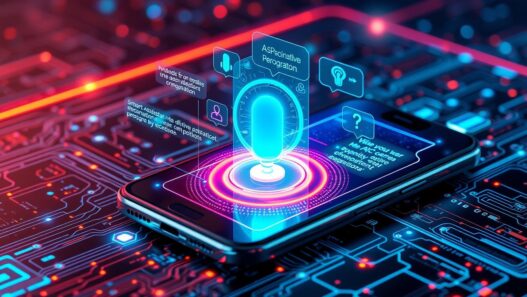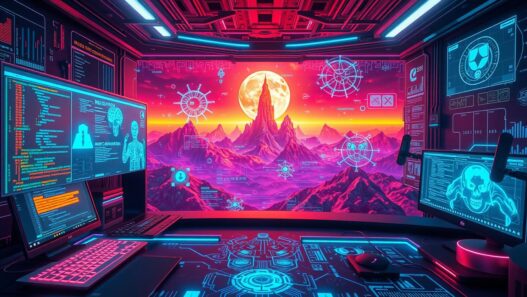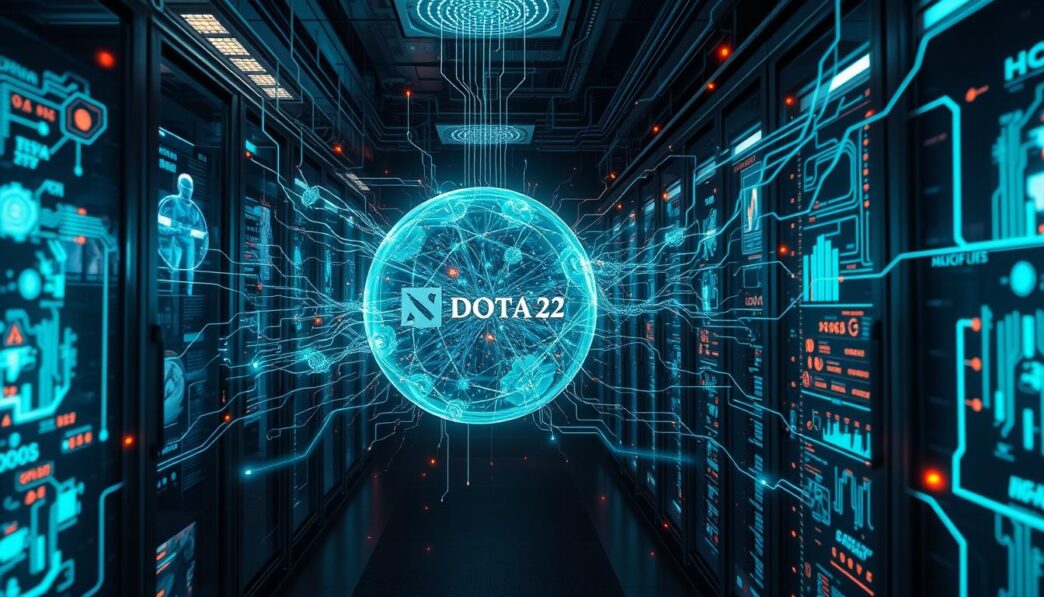On a special day, April 13th, 2019, the world of esports saw a major event. OpenAI Five defeated the Dota 2 world champions. This victory began a new chapter for esports AI and artificial intelligence milestones. It wasn’t just about winning a game. It showed the power of deep reinforcement learning in AI gaming. We saw how advanced AI training systems have become1.
Key Takeaways
- Deep reinforcement learning was key to the success of OpenAI Five.
- The win by OpenAI Five marks a big step in artificial intelligence.
- Systems like Dota 2 AI by OpenAI Five are leading the way in AI gaming.
- OpenAI Five’s AI training systems skillfully managed complex game plans.
- Through constant improvement, OpenAI Five reached superhuman levels in esports AI1.
The Triumph of OpenAI Five: A Milestone in AI Esports
OpenAI Five won in the challenging world of Dota 2. This win is a big deal in artificial intelligence and AI esports. It shows how advanced AI is in taking on complicated AI challenges.
Understanding the Significance of OpenAI Five’s Victory
OpenAI Five’s win is a big step in using machine learning. It shows powerful abilities that go beyond esports to real-world uses. These technologies matter in fields that need fast decisions and close oversight.
Challenges Present in Dota 2 for AI Systems
Dota 2 needs quick thinking and knowledge of various patterns. It’s a test to see how AI compares with human skill and team work. OpenAI Five’s win is a key moment, showing AI can handle difficult tasks, possibly in other complex areas too2.
The Road to Defeating the Dota 2 World Champions
Getting to the top wasn’t just about power for OpenAI Five. It was about smart learning and adjusting, using reinforcement learning in new ways. The AI learned from each game, getting better and finally outplaying top human gamers in Dota 22.
| Feature | Impact on AI Development | Impact on Esports |
|---|---|---|
| Real-Time Decision Making | Enhances AI response time and accuracy. | Raises the competitiveness in esports. |
| Strategic Adaptation | Improves AI learning capabilities. | Changes tactics and dynamics of the game. |
| Continuous Improvement | AI evolves to handle more complex tasks efficiently. | Elevates the level of gameplay to new standards. |
Adding AI to esports changes the game and opens new doors. It shows what AI can do in complex, strategic settings.
Deep Reinforcement Learning: The Core of OpenAI Five’s Strategy
Deep reinforcement learning is at the forefront of AI in competitive gaming, especially in Dota 2. It’s a learning method that allows an AI to adjust and learn on its own. OpenAI Five uses this powerful approach to beat human champions by learning continuously.

Unpacking Reinforcement Learning Techniques
Deep reinforcement learning combines classic reinforcement learning with deep neural networks. It stands at the crucial point of predictive analytics and behavior-based AI. Remarkably, OpenAI Five trained on a whopping 45,000 years’ worth of Dota 2 gameplay in just ten months, mastering the game faster than humans could3.
Scale and Adaptation: Learning from Millions of Frames
OpenAI Five’s system is built to handle vast amounts of data, analyzing endless possibilities. It manages up to 800 petaflops per second, adapting based on real-time feedback3. Each training session helps the AI improve its strategies and outsmart opponents with innovative tactics. These tactics often baffle even the most experienced Dota 2 players3.
Continuous Improvement: The Mechanism Behind AI Superiority
AI stands out not just because of its computing power but also through strategic use of neural networks and self-play. It keeps getting better by playing against versions of itself, evolving unpredictably4. OpenAI Five shows exceptional adaptability in strategy development, mastering a complex game with limited character choices3.
| Feature | Description |
|---|---|
| Self-Play | AI competes against previous versions of itself, enhancing learning algorithms. |
| Computational Power | Uses 800 petaflops per second and 512 GPUs for real-time optimization34. |
| Adaptability | Capable of modifying tactics based on gameplay, with no additional training between sessions. |
| In-game Strategy | Utilizes unconventional game tactics like early revival of characters, which aren’t typically used by human players3. |
For a deeper understanding of how AI took Dota 2 by storm and reshaped AI across sectors, read this in-depth analysis on OpenAI Five’s epic win.
Dota 2 with large scale deep reinforcement learning
In the fast-changing worlds of esports and computing, introducing large scale deep learning to games like Dota 2 marks a big step in AI use. The journey of OpenAI Five has created new standards for how AI can get good at very complex games.
Comprehensive Analysis of Large Scale Deep Learning Models
OpenAI Five, after 10 months of intense training, shows the strength of large scale deep learning. This AI beat more than 7000 Dota 2 players 99.4% of the time, showing deep learning’s ability to grow and get better through hard work and fine-tuning5. Playing with just 17 heroes, it proved that AI could master games even with limited options5.
The Integration of AI in Complex Continuous State-Action Spaces
Dota 2’s game world is fast and complex, with a lot happening every second and games that can last 45 minutes5. This world challenges AI to make quick, smart decisions that keep up with the game. OpenAI Five stands out for handling about 20,000 decisions each game, showing the importance of AI in complex games5.
Self-Play Reinforcement Learning: Pathway to Mastery
OpenAI Five got better by playing against itself, a technique called self-play reinforcement learning. This way, it kept improving its game strategies without needing people. It learned to adapt its gameplay to different opponent styles, facing a huge number of players online, up to 1 million at Dota 2’s peak5.
Behind the Scenes: The Infrastructure Powering AI Dominance in Dota 2
The OpenAI Five’s success in esports relies a lot on its AI training infrastructure. It uses a large network of processors. These processors handle huge amounts of data, boosting AI in gaming6.
To train the Dota 2 bots, OpenAI rented 128,000 CPUs and 256 GPUs for weeks. This shows the massive computational resources used6. Such a big setup indicates lots of financial support. It also shows the intense training needed to compete globally.
Spending on this AI project wasn’t small, costing OpenAI $7.9 million in 20176. Then, OpenAI decided to become a for-profit. Microsoft gave them $1 billion. This shows Microsoft’s strong belief in OpenAI’s tech6.

| Year | Investment in AI | Computational Resources Used |
|---|---|---|
| 2017 | $7.9 million on cloud computing6 | N/A |
| 2018 | $13 billion from Microsoft6 | 128,000 CPUs, 256 GPUs6 |
| 2019 | $1 billion investment package from Microsoft6 | N/A |
The OpenAI Five’s work has really changed how we see AI in esports. It has raised the bar for AI’s role in competitive gaming.
Conclusion
The journey of OpenAI Five in mastering Dota 2 marks a big leap for AI. It shows a huge change in esports technology. The use of six networks for choosing actions7 goes beyond what simpler AI uses. This mirrors big steps in AI research. It shows AI’s growing skill to handle complex situations and keep getting better, which is key for AI’s future.
OpenAI Five is known for its win and how it learned. This shows the strength of careful training and figuring out rewards7. It started by just moving in the middle lane to get XP. Now, it shows AI can come up with strategies on its own7. But, there are challenges in machine learning, like losing the ability to adapt in deep learning. Yet, new methods like continual backpropagation are trying to fix this8.
Looking ahead, we see OpenAI Five’s big wins in Dota 2 and the impact on AI research. Learning methods that keep the ability to adapt8 are making way for smarter systems. These can learn and adapt non-stop, which is vital for solving real problems. From understanding language to robotics, OpenAI Five’s work is sparking new chances in many areas. It puts AI at the center of tech progress8.




















